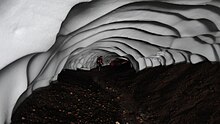Glacier cave
This article needs additional citations for verification. (October 2023) |
This article includes a list of general references, but it lacks sufficient corresponding inline citations. (December 2013) |


A glacier cave is a cave formed within the ice of a glacier. Glacier caves are often called ice caves, but the latter term is properly used to describe bedrock caves that contain year-round ice.[1]
Overview
[edit]
Glacier caves form in the bottom edge of glacier ice. Although with low permeability in glacier ice, most glacier caves are started by water running through or under the glacier. This water often originates on the glacier's surface through melting, entering the ice at a moulin and exiting at the glacier's snout at base level. Heat transfer from the water can cause sufficient melting to create an air-filled cavity, sometimes aided by solifluction. The water flow must dissipate enough heat to keep the glacier ice refreezing in polar areas. Air movement can then assist enlargement through melting in summer and sublimation in winter. Meltwater reaches the bottom of the ice sheet through basement melting caused by geothermal heating and the melting of the ice surface under the pressure of the weight of the ice above. The downward infiltration are made of flow of melting superice in glacial systems.
Some glacier caves are formed by geothermal heat from volcanic vents or hotsprings beneath the ice. Magma from volcanic activities reaches the bottom of glaciers and thus creates caves and channels to further form caves. An extreme example is the Kverkfjöll glacier cave in the Vatnajökull glacier in Iceland, measured in the 1980s at 2.8 kilometres (1.7 mi) long with a vertical range of 525 metres (1,722 ft).
Many glacier caves are relatively unstable due to heat transportation and glacial motion, and are subject to localized or complete collapse, as well as elimination by glacial retreat. An example of the dynamic nature of glacier caves is the former Paradise Ice Caves, located on Mount Rainier in the United States. Known since the early 1900s, the caves were thought to have disappeared altogether in the mid-1940s, yet in 1978 cavers measured 13.25 kilometres (8.23 mi) of passageways in glacier caves there, and it was then considered the longest glacier cave system in the world. The Paradise Ice Caves collapsed and vanished in the 1990s, and the lower lobe of the glacier which once contained the caves has also vanished entirely between 2004 and 2006.
Glacier caves may be used by glaciologists to gain access to the interior of glaciers. The study of glacier caves themselves is sometimes called "glaciospeleology".
Examples
[edit]- Mount Rainier (Washington, US) Two craters on top of a cone on the volcano's summit contain the world's largest volcanic ice-cave system.[2]
- Perito Moreno Glacier (Argentina)
- Titlis (Switzerland)
See also
[edit]- Ice cave – Natural cave that contains significant amounts of year-round ice
Further reading
[edit]- W. R. Halliday, Glaciospeleology Cave Science Topics, Caving International no. 4, July 1979.
- J.Schroeder, Inside the Glaciers – Svalbard, Norway The Canadian Caver vol.22 no.1, 1990.
References
[edit]- ^ Nanna Gunnarsdóttir (n.d.). "Caves in Iceland". Guide to Island, a collaboration of more than 300 travel companies and individuals. Retrieved 20 January 2015.
- ^ Zimbelman, D. R.; Rye, R. O.; Landis, G. P. (2000). "Fumaroles in ice caves on the summit of Mount Rainier; preliminary stable isotope, gas, and geochemical studies". Journal of Volcanology and Geothermal Research. 97 (1–4): 457–473. Bibcode:2000JVGR...97..457Z. doi:10.1016/S0377-0273(99)00180-8.
External links
[edit]![]() Media related to Glacier cave at Wikimedia Commons
Media related to Glacier cave at Wikimedia Commons
- ^ Kiernan, Kevin; Jones, Rhys; Ranson, Don (1983). "New evidence from Fraser Cave for glacial age man in south-west Tasmania". Nature. 301 (5895): 28–32. Bibcode:1983Natur.301...28K. doi:10.1038/301028a0. ISSN 0028-0836.
- ^ Petrovová, Veronika; Ľuptáčik, Peter; Kolarčik, Vladislav; Kováč, Ľubomír (2024). "Biodiversity of a temperate karst landscape–ice cave collapse doline supports high α-diversity of the soil mesofauna". Scientific Reports. 14 (1): 22205. Bibcode:2024NatSR..1422205P. doi:10.1038/s41598-024-72738-9. ISSN 2045-2322. PMC 11437136. PMID 39333176.
- ^ Spötl, Christoph; Baker, Jonathan L.; Skiba, Vanessa; Honiat, Alexandre; Fohlmeister, Jens; Luetscher, Marc; Trüssel, Martin (2024). "Speleothems in subglacial caves: An emerging archive of glacial climate history and mountain glacier dynamics". Quaternary Science Reviews. 333: 108684. Bibcode:2024QSRv..33308684S. doi:10.1016/j.quascirev.2024.108684.
- ^ Fountain, Andrew G.; Walder, Joseph S. (1998). "Water flow through temperate glaciers". Reviews of Geophysics. 36 (3): 299–328. Bibcode:1998RvGeo..36..299F. doi:10.1029/97rg03579. ISSN 8755-1209.
- ^ Irvine-Fynn, Tristram D. L.; Hodson, Andrew J.; Moorman, Brian J.; Vatne, Geir; Hubbard, Alun L. (2011-11-05). "Polythermal Glacier Hydrology: A Review". Reviews of Geophysics. 49 (4). Bibcode:2011RvGeo..49.4002I. doi:10.1029/2010rg000350. ISSN 8755-1209.
- ^ Gulley, Jason D.; Fountain, Andrew G. (2007), "Glacier caves", Encyclopedia of Caves, Elsevier, pp. 468–473, doi:10.1016/b978-0-12-814124-3.00056-x, ISBN 978-0-12-814124-3
